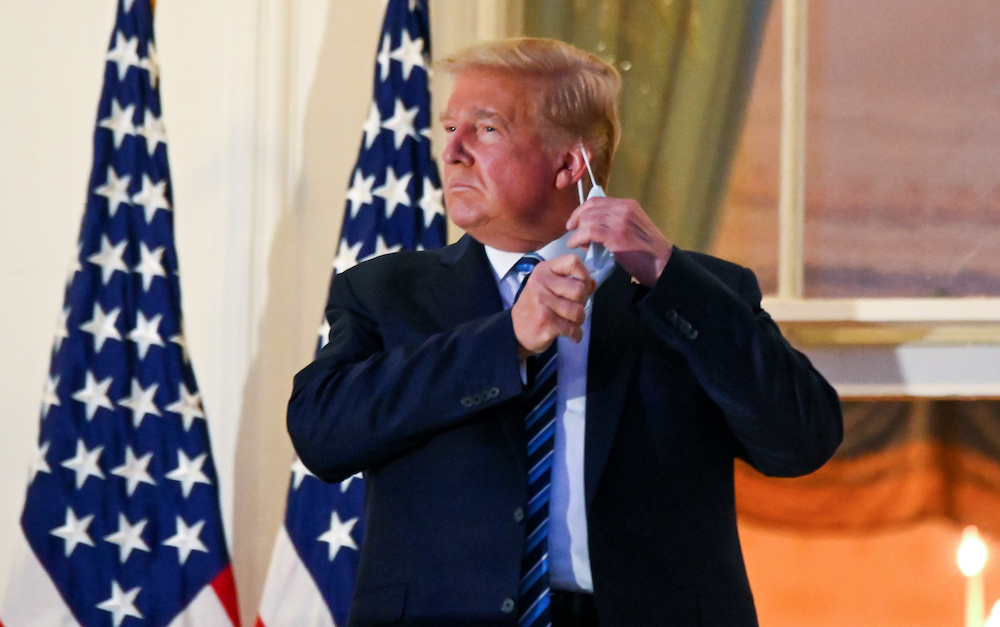On Monday evening, President Donald Trump gently touched down on the White House lawn in Marine One after a weekend treatment for Covid-19 at Walter Reed Medical Center.
He mounted the steps, removed his mask, saluted, and proceeded to make a short video he soon tweeted out to the world. Infected with a virus that had already killed more than 200,000 of his fellow Americans, Trump encouraged the public not to be afraid of the scourge and even promised—without giving specifics—that "the vaccines are coming momentarily."
Trump’s balcony scene was arguably emblematic of his M.O. as president during a global Covid-19 meltdown — a sudden move that set off an immediate chain reaction of kudos from his allies and an outcry from detractors. It was yet another gust in the breaking-news cyclone that has pushed the big cable outlets and their non-stop news programming into overdrive.
Related Reading
With mis- and disinformation campaigns heating up, a vacancy on the supreme Court, and a President who refuses to commit to accepting the results, the 2020 election arrives at a period of extraordinary uncertainty and tension. Nieman Reports and Nieman Lab are publishing a collection of stories exploring how newsrooms are covering this intensely contested vote and its aftermath.
How Should Journalists Respond to Trump’s Refusal to Commit to a Peaceful Transfer of Power?
By Issac J. Bailey, Nieman Reports
The election could be contested and last for weeks after Nov. 3. Here’s what experts think journalists should know.
By Sarah Scire, Nieman Lab
A new study shows how Trump and the RNC duped traditional media into covering mail-in voter fraud
By Laura Hazard Owen, Nieman Lab
Cable news has had years to get ready to navigate the fog of misinformation, partial information, and acrimony surrounding the Covid-19 diagnosis of Trump, a leader who has aggressively downplayed the perils of the virus. It’s also had his nearly four-year tenure in the White House to redefine its coverage of the president during the 2016 election, including addressing criticisms that Trump had gotten too much airtime with too little fact-checking and pushback.
Knowing what they know about Trump, how are the top cable news outlets handling a competitive, relentless, politically charged presidential health care crisis and election campaign where vague, conflicting information is at times the best they have to work with? Reporters and producers have been confronted at every turn with mixed messages, unanswered questions, and accusations of bias in unpacking the political and health complexities of the story.
Danielle Robinson Bell, assistant professor of strategic communications at Northwestern’s Medill School, says, "Despite President Trump’s diagnosis, the White House seems focused on pushing the narrative that he is very much still in command and still in the race for president. Fox seems to be treating this information as not only factual but sufficient. CNN and MSNBC seem to be treating this information as insufficient and with a great deal of skepticism and scrutiny because, sadly, misinformation and conflicting information have been a hallmark of this administration.”
Spokespeople for CNN, Fox, and MSNBC did not immediately respond to requests for comment for this story.
In looking at coverage of the Trump Covid-19 crisis, Joel Kaplan, associate dean of graduate professional programs at Syracuse’s Newhouse School, says it’s reasonable to allow that the Trump Administration isn't the first to downplay or withhold details about a president's health: “Roosevelt was never shown in a wheelchair, right? And John Kennedy had Addison's Disease and all these other things. So it's not like this is new — but it's new for certainly the modern era, the post-internet era, that you have this type of opacity.”
Times have changed since the days of FDR and JFK — and since the advent of the Trump Era, when cable networks fed an audience appetite for blow-by-blow, uncut coverage of his every move and doubled back to fact-check him later. In Trump’s case, says Kaplan, “This has been a long time coming ... We’ve gone through all the cycles of the New Journalism — ‘[We’re] just going to be objective. We’re going to just report what he says,’ [to saying] ‘There's no evidence of this,’ [to] ‘This is just wrong.’ They went from ‘misleading’ to ‘false’ to ‘lies.’ But it had [become] ingrained by the time Covid hit in February that [Trump] made all these misleading statements. So there was no transition for Covid. [Cable news] went straight into that, because he wasn't trustworthy."
Tom Jones, senior media writer for the Poynter Institute, says cable channels don’t need to preface or apologize for reports that are rigorous in covering Trump’s diagnosis and reminding viewers of his false statements about the virus. “You can be critical of the administration for what their attitudes have been on masks and social distancing and so forth and [you're] not saying, 'See, I told you he was going to get it.' You don't have to say it was karma," according to Jones.
Jones, like other observers, sees Fox as more inclined to take positive news from Trump and his team at face value, and that's been at least as evident in coverage of Covid-19 as it has been in general. In rolling coverage and updates of Trump's condition, he says, Fox seems to have emphasized more optimistic framings of the president’s condition and prospects, while CNN and MSNBC have leaned harder into grimmer prognoses.
Even now when Trump and at least 13 people in his immediate circle have tested positive for the virus, Fox still does not push back as frequently as other networks when somebody from the administration claims something that deserves to be at least asked about. On Sunday, Fox anchor “Chris Wallace did a really good job pushing back on [Covid-19 issues regarding the first presidential debate], like, ‘Look, I was there in Cleveland. You guys weren’t wearing a mask. That’s a fact,’” Jones says. “But when you watch something like Hannity, and you watch Laura Ingraham, when you watch Tucker Carlson, they’re going to let a lot of things go unchecked, and [it] does seem like they’re in it together at that point … Because of the lies and misstatements we’ve heard over the last four years, the cable networks do have every right to be a little more skeptical.”
That’s as it should be, says Darrell West, vice president and director of governance studies at The Brookings Institution: Trump deserves strong scrutiny because he has a weak relationship with honesty. “The President embellishes, distracts, and distorts the truth on a regular basis, and it is challenging for cable news to keep up with him on this front,” he says. “The news media need to call him on this situation. Cable news has gotten better at fact-checking Trump over the past few years. Executives realize they can attract audiences by criticizing as well as covering him, [and] reporters are better at comparing his statements to behavior and noting the gulf between the two.”
Celeste Katz Marston has spent 25 years reporting for newspapers, magazines, and radio with a specialty in politics, elections, and voting rights.



